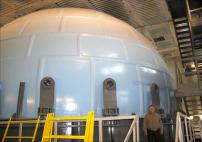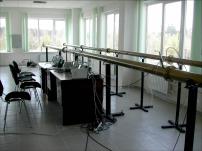Efficient methods of controlling gas combustion, explosion and detonation
The following methods are mainly used in industry to ensure gas fire and explosion safety: diluting the combustible gas mixture with inert gases to a safe concentration, reducing the gas medium temperature to a level, at which no ignition takes place, etc. These methods are not always effective, have limited applicability and are used mainly for the termination of combustion, and not its prevention.
The essence of the proposed method is the preventive introduction of small amounts of gas-phase reactive additives (inhibitors) to the protective medium. The proposed inhibitors not only prevent the development of combustion and explosion, but also greatly obstruct inflammation.
The method is based on the development of the gas combustion theory. For a long time, it was commonly assumed that the combustion of gases is mainly due to progressive self-heating of the reacting system, i.e. thermal ignition. It was also believed that the chain mechanism plays an important role only at pressures of tens and hundreds of times lower than atmospheric, actually in the absence of self-heating.
Researchers of the Institute of Structural Macrokinetics and Materials Science RAS (ISMAN) showed that the patterns of combustion and explosion of mixtures of most gases, including hydrogen and methane with air, are determined by the chain nature of these processes not only at pressures of hundreds of times lower than atmospheric, but also at any higher pressures. Accordingly, the patterns of these processes are determined by the competition of branching and termination of reaction chains. With reference to the laws of chemical kinetics, this implies that by controlling the impact on chain reactions using chemically reactive additives (inhibitors) it is possible to control combustion, explosion, and detonation.
Inhibitors are especially selected substances that effectively react with atoms or radicals resulting in the formation of inactive products. Experiments have shown that inhibiting can suppress combustion and explosion at all initial temperatures at least up to 1500 K and initial pressures up to hundreds of atmospheres.
The chemical composition of the inhibitors and the procedure for their use are determined by the nature of the combustible gases and the specific task of controlling the characteristics of combustion, explosion and detonation, including the prevention of these processes.
Researchers of the Institute of Structural Macrokinetics and Materials Science RAS and the Joint Institute for High Temperatures RAS (JIHT RAS), with the financial support of the Konti Group, have developed methods of chemically controlling gas combustion, explosion and detonation, as well as effective inhibitors, allowing to regulate the combustion characteristics of hydrogen, methane, synthesis gas and provide their explosion safety.
The Conti Group is a major investment and construction holding company providing a full cycle of integrated construction management of residential, industrial and commercial properties.
Development and implementation of strategies, investment programs, and projects are carried out by the Management Company – the governing body of the Konti Group.
Supported by the Coordination Board, Strategic, Budget, Investment, Tender and Personnel Committees, the Management Company organizes project and budget planning, bears responsibility for investment and personnel policies, exercises operational management of the subsidiaries and entities providing legal, financial and accounting support of their operations.
In 2005, the Konti Group was successfully certified to the international quality management standard ISO 9001:2000. An important stage in the development of the company was the deployment of a modern management system, which is capable of supporting project development of any level and scale: development projects, real estate construction meeting international standards, projects in the field of industrial development. Thanks to a streamlined production cycle and optimal project management system, it is possible to achieve high quality work under tight deadlines simultaneously on a large number of sites.
All the issues of automating system components and stages of the management processes of the Group have currently been resolved, from goal-setting and planning to sustainable automated monitoring of all projects aimed at achieving the operational and financial targets of the corporate strategy.
In 2009-2010, the company's development strategy for the period up to 2015 was updated allowing the implementation of balanced performance indicators and improvement of ERP processes.







